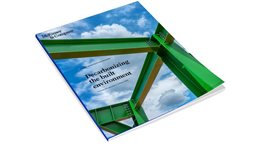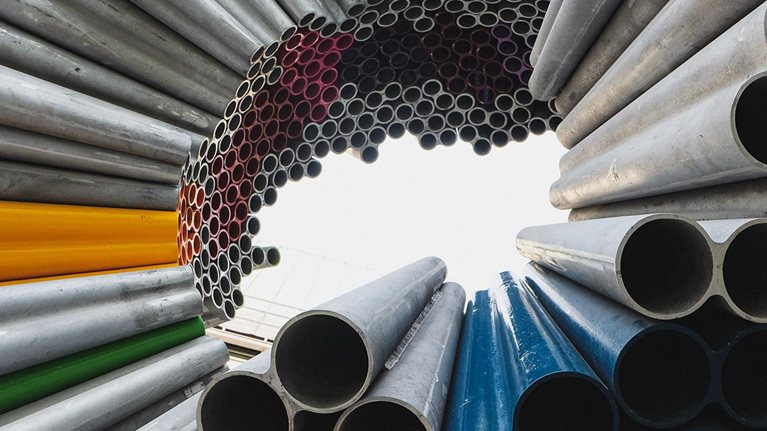Embodied carbon—the greenhouse-gas (GHG) emissions associated with construction—is by nature irreversible once an asset is built. Embodied carbon includes the CO2 emitted from extraction and manufacturing processes to create construction materials and the transport of materials and equipment to a project site, as well as all the emissions associated with the actual construction operations required for the installation of the materials.
These emissions during construction are a major contributor to lifetime emissions for capital projects (Exhibit 1). While operations may have decarbonization opportunities long after construction completion, the embodied-carbon emissions from construction are set in stone as the project is executed. Up-front carbon emissions account for up to 50 percent of total life cycle emissions.

The building operations industry is seeing a clear push toward greener energy sources and optimizing carbon emissions1—but reducing embodied carbon during construction is a low priority at best and an afterthought at worst. The focus during design is usually on operational-carbon reduction, not embodied-carbon reduction, and operational carbon is also the focus of several certifications (such as LEED) that allow a more structured approach to reducing those emissions. Buildings are also built with the materials available, and given that low-embodied-carbon materials are often more expensive than traditional building materials, companies are not compelled to use them unless they are industry leaders in the practice.
The time is now for industry leaders to make tackling embodied emissions a priority. The long-term impact of what we’re building today creates a huge opportunity for construction companies—whether they are currently leaders in reducing operational emissions or not—to set the standard for the design choices, materials selection, and construction practices that reduce a project’s embodied-carbon footprint.
Would you like to learn more about our Global Infrastructure Initiative?
New construction: $7.2 trillion in annual spending
According to McKinsey analysis of the NGFS Net Zero 2050 scenario,2 $9.2 trillion per year will need to be spent on capital assets to meet global net-zero targets set forth in the Paris Agreement by 2050.3 Of that $9.2 trillion, $2.0 trillion will need to be applied toward retrofits, equipment upgrades, and improvements to existing assets. The other $7.2 trillion—more than three-quarters of the total—needs to be spent on new construction. This massive building effort will have a significant impact on global carbon emissions, and that’s why it is crucial for companies throughout the infrastructure value chain to prioritize embodied emissions as they build their project plans.
Those project plans will proliferate in the coming years as thousands of new assets come online around the world. The IEA estimates that to decarbonize in line with Paris Agreement targets, renewables deployed must increase fourfold, hydrogen production must increase sixfold, and battery demand must increase a staggering 70-fold (Exhibit 2). This will all be crucial to facilitate the 190-fold increase in CO2 captured per year—and scaling construction is quickly becoming the bottleneck that could prevent us from reaching net-zero goals.

New capital spending on assets considered to have low operational-carbon emissions, such as renewable energy sources, will account for roughly 70 percent of capital expenditures through 2050, according to McKinsey analysis of data from the Network for Greening the Financial System (Exhibit 3)—which is good news for the future of operational emissions.4

However, many assets with low operational emissions use the same construction materials and processes that are used for high-operational-emissions projects—meaning the up-front embodied-carbon footprint may be the same. Meanwhile, the urgency of reducing carbon emissions has never been higher: experts say we need to cut total emissions in half by 2030 to stay on track for Paris Agreement objectives.5 Embodied emissions could—and will have to—play a leading role in those reductions.

Voices on Infrastructure: Decarbonizing the built environment
The path forward
Fortunately, a significant amount of embodied emissions can be reduced by using alternative or unconventional construction processes and materials. Adoption of three practices can help those seeking to be at the forefront of tackling embodied carbon to take advantage of practical opportunities.
Expand adaptive reuse
Repurposing an existing building, or adaptive reuse, can be a low-carbon way to expand a company’s physical footprint without producing as much embodied carbon. Adaptive reuse usually requires less materials to build out, resulting in lower quantities of building materials and potentially increasing the incentive to use sustainable materials. Developers and engineers can specifically incorporate more sustainable designs with a focus on reducing embodied carbon through lowering material quantities. Sustainable designs that repurpose an existing building or asset have flourished as trendy options for restaurants, breweries, retail stores, and other consumer-facing businesses. Adaptive reuse can also revitalize underused areas of cities, which can further reduce the need for new infrastructure to support new development. Adaptive reuse projects can also provide opportunities for time and cost savings compared with their new-build-project counterparts.
Shift to lower-carbon building materials
The market for low-embodied-carbon building materials needs targeted support to mature. For example, Kingspan and Peab are partnering with H2 Green Steel and SSAB, respectively, to utilize low-CO2 steel in their construction materials. As more steelmakers see the benefit of producing low-CO2 steel, they can hasten the transition away from the traditional carbon-intensive steel production process. Further, this same mentality can be applied to material fabrication processes such as solar panels to provide more low-embodied-carbon material choices for both high-and low-operational-emission capital projects.
Without an incentive for cleaner, more efficient manufacturing and fabrication processes or the development of less-carbon-intensive construction materials, industry and government leaders will struggle to align and could potentially delay the ecosystem’s large-scale shift to lower-carbon materials.6 Clarifying funding options, incentives, and sustainability requirements will help push material suppliers to prioritize meeting targets for reducing the carbon footprint of their portfolio of construction materials.
Embrace greener construction equipment
Traditional diesel-powered construction equipment used in construction operations contributes roughly 3 percent of embodied carbon for new-build construction projects, according to our analysis. The available options for low-emission, electric construction equipment require a substantial investment by a contractor and often deliver lower performance compared with a traditional diesel-powered piece of equipment. However, some equipment manufacturers are at the forefront of developing zero-emission construction equipment. Liebherr, for example, developed an electric crane that the company says performs on par with diesel-powered comparators. Such innovations will be important to fostering scale in green-construction equipment and practices.
Three actions—repurposing existing assets or materials, using lower-emission materials, and using electric construction equipment—can each lower embodied carbon on most construction projects, regardless of what is being built. The industry remains nascent in its efforts to address embodied carbon, but companies at the forefront could quickly demonstrate what it looks like to be a leader in fighting change by reducing embodied carbon.
This article is part of Global Infrastructure Initiative’s Voices on Infrastructure.


